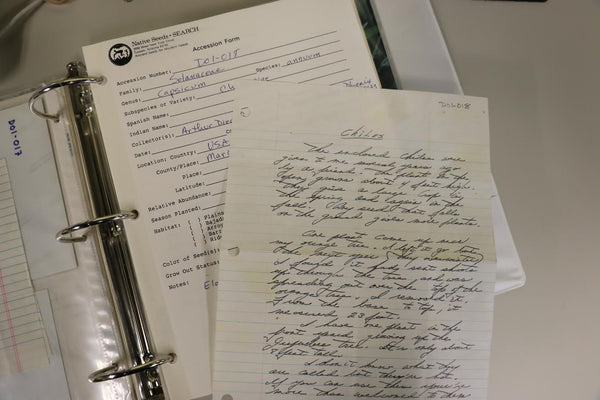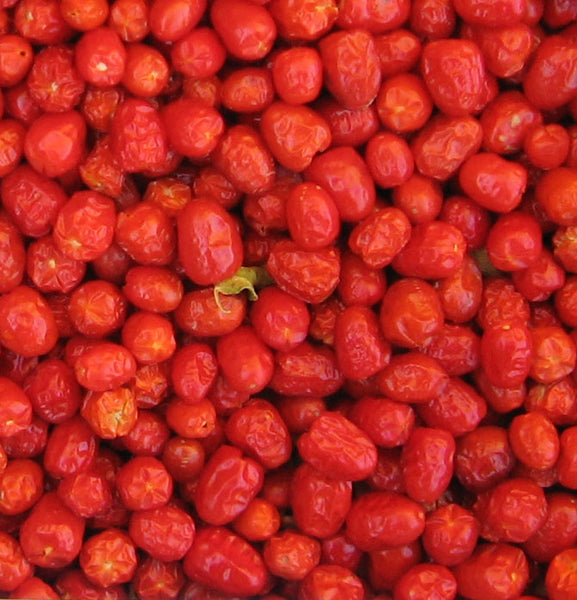
One of the wonderful things about working at Native Seeds/SEARCH is that you never know when you will uncover a treasure … which is not so surprising in a storehouse full of treasures like this one! With over 1900 different seed accessions stewarded in our seed bank, most of which have multiple samples, there is always something interesting to learn about.
By Sheryl Joy, NS/S Seed Distribution Coordinator.
One of the wonderful things about working at Native Seeds/SEARCH is that you never know when you will uncover a treasure … which is not so surprising in a storehouse full of treasures like this one! With over 1900 different seed accessions stewarded in our seed bank, most of which have multiple samples, there is always something interesting to learn about.
Maggie (one of our great volunteers) and I came across several varieties of chiltepin seed that had been safely set aside after a busy harvest some years back. Maggie ran germination tests on the seeds, to be sure they were healthy and able to sprout, which they were. These were eleven different chiltepin accessions (or collections) that had not previously been available to the public. After separating samples for long-term storage in the seed bank, there was an abundance of seeds to make these varieties available for distribution through sales and our seed grant programs. So I inherited the fun task of researching the seeds to see what information we have about them so we could pass along the stories with the seeds.
You see, some of the treasures housed here at NS/S are not seeds. We have a great big set of full-to-bursting notebooks that house seed histories. Each time seeds were collected or donated to NS/S, they were accompanied by a piece of paper that described what we knew about them. Sometimes these sheets held the barest bit of info … what kind of seed, and where they were found and when. But SOMETIMES the papers told rich and wonderful stories, and I ran across several of those during this chiltepin research project.
Accession records
One of these was a story handwritten in slanted script (some people still wrote letters in the late 1980’s) about a tiny elongated chile that a man received from a friend of his. He planted the seeds in his yard in Phoenix, and over the course of several years they began to reseed and volunteer around his yard. In his words, “One plant came up near my orange tree. I let it go but the next year I found it had sent shoots up through the tree and was spreading out over the top of the orange tree. I removed it. From the base to the top, it measured 23 feet.” He also had another plant that partnered with a jujube tree and grew to “only about 8 feet tall”. This is the seed we are calling the Phoenix Chiltepin.
Another handwritten letter came to us in 1993 and told the story of a chiltepin that was wild-harvested in 1952 by a border patrol agent along the Devil’s River near Del Rio, Texas. There was a drought at the time, and the river was dry. The collector had no water with him, so when he dug up three little plants from under a mother plant, he spat on a paper napkin to wrap the roots in. The collector shared the plants with another family who also shared seeds with anyone who wanted them and eventually donated some to us. The woman who wrote us the letter grew up along with these chiltepin plants and their tiny round bright red fruits in her mother’s yard. She said “I remember vividly somewhere around the age of 5-7, giving them to the little boy who lived behind us and telling him they were candy. We called him Mean Mike and he dropped a brick on my head from the top of the fence. I’m not sure in which order the chiltepin-brick incidents occurred, though.” Anyone who has tasted fiery chiltepines might understand Mike’s desire to drop a brick on someone who called them candy!
Devils River Chiltepin
We might have decided to call this the Brick-on-the-Head chiltepin, but instead it is named for an even more poignant part of the story. The place where the baby plants were collected no longer hosts any chiltepines, as it is deep under the water of the Amistad Reservoir, which began flooding the area in the late 1960’s. So this chiltepin is named Devil’s River in honor of those riverbanks that are no longer.
Both this donor family and the original collector continued to steward this chiltepin for many years, though both moved several times and had to go to some effort to keep seeds or plants with them. Theirs is one of countless stories of people who have safeguarded seed diversity over years and over generations, and whose seed-saving has made the work of Native Seeds/SEARCH possible.

Phoenix Chiltepin
Please join us in this work by growing and saving seed of your own choosing, and sharing your own seed stories! If you want to carry on these seed stories by planting one of these chiltepines. While these chiltepines may all look similar, the genetic diversity encapsulated within these seeds is extremely important to ensure the continued survival and resilience of economically and socially important chiles.


